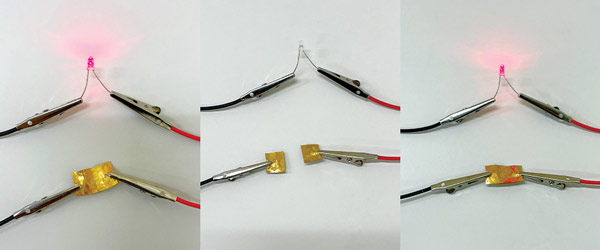
Figure 1: The self-healing conductor is able to rejoin itself (right) when pieces that have been split are brought together after being cut (middle). © 2025 RIKEN Center for Sustainable Resource Science
A new self-healing polymer that is highly suitable for use as a flexible conductor in wearable devices and robots has been created by RIKEN chemists1.
Electrical conductors used in conventional electronic devices tend to be brittle and inflexible. That makes them unsuitable for use in applications that involve repeated flexing, such as wearable electronics and robotics.
To solve this problem, researchers are seeking to produce robust and flexible conductors for these applications. It is highly desirable that these conductors should also be self-healing so that they can repair themselves after being damaged.
"In practical scenarios, these conductors are prone to mechanical damage from repeated deformations, which compromise their reliability and shorten their service life," explains Zhaomin Hou of the RIKEN Center for Sustainable Resource Science. "Incorporating self-healing capabilities can effectively address these issues by restoring functionality after damage."
A promising strategy for making such flexible conductors is to use a self-healing polymer as a flexible base and incorporate gold nanoparticles or nanosheets on it, which can conduct electricity. However, endowing polymers with self-healing and adhesive properties is not easy.
Now, Hou and his co-workers have demonstrated that modifying common polymers known as polyolefins with a sulfur-containing group (thioether) produces a self-healing polymer that can be used for flexible conductors.
"Polyolefins are ubiquitous in daily life and account for the largest production volume among all polymers," says Hou. "They combine several desirable properties, including low cost, robust mechanical strength, ease of processing, and excellent chemical and environmental stability, making them promising candidates for conductor applications."
The secret to the team's success was the use of a novel catalyst that enabled them to easily incorporate thioether in a highly controllable manner.
"Our work demonstrates that catalyst-controlled copolymerization of olefins with different properties can serve as a useful protocol for synthesizing polyolefin materials with multiple functions for advanced technologies," notes Hou. "These findings may inspire further explorations in this area."
One advantage of the approach is that sulfur and gold have a natural affinity for each other, which ensured a strong bond between the self-healing polymer and gold coatings. "The durability of the gold coating on the thioether-functionalized polymer far exceeded our expectations," says Hou. "It was resistant to more than 50 cycles of a tape-peeling test."
By using different building blocks for polyolefins, the team intends to "create a brand-new family of self-healing polymers for flexible conductors with further higher durability, as well as for other advanced technologies," says Hou.






